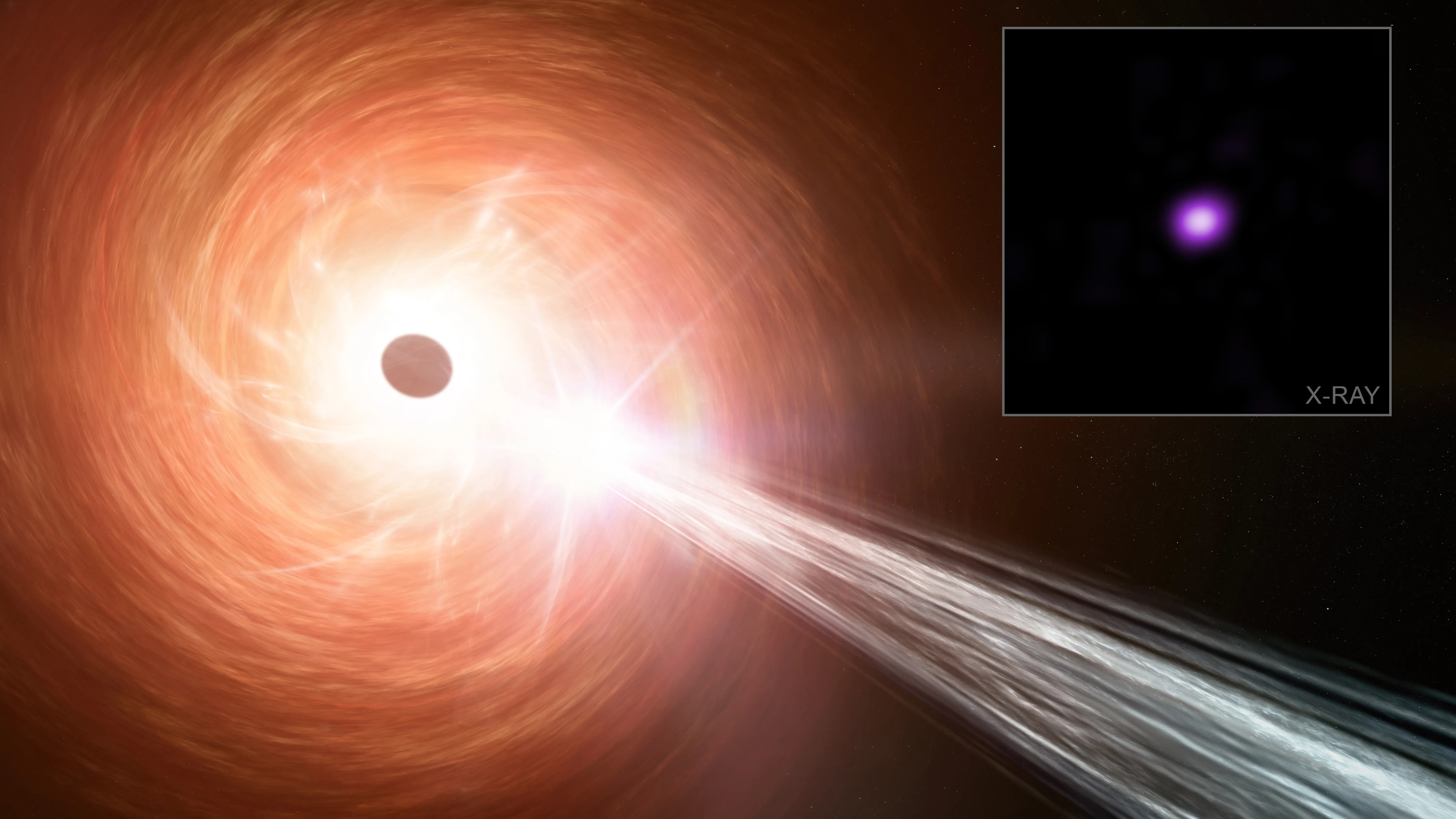By Brandon Specktor
Copyright livescience

Skip to main content
Close main menu
Live Science
Sign up to our newsletter
View Profile
Search Live Science
Planet Earth
Archaeology
Physics & Math
Human Behavior
Science news
Life’s Little Mysteries
Science quizzes
Newsletters
Story archive
Lab brains could become conscious
Jaguar smashes swim record
Mysterious hand positions on Maya alter
It’s too late to stop AI, readers say
Anthropologist Ella Al-Shamahi on human origins
Don’t miss these
Black Holes
This supermassive black hole is eating way too quickly — and ‘burping’ at near-light speeds
Black Holes
Colossal black hole 36 billion times the mass of our sun is one of the largest ever seen in the universe
Black Holes
James Webb telescope spots earliest black hole in the known universe, looking ‘as far back as you can practically go’
Black Holes
Scientists detect most massive black hole merger ever — and it birthed a monster 225 times as massive as the sun
Black Holes
Astronomers use rare ‘double zoom’ to view black hole corona in unprecedented detail
Black Holes
See the universe’s rarest type of black hole slurp up a star in stunning animation
Black Holes
X-ray telescope finds something unexpected with the ‘heartbeat black hole’
Black Holes
Exotic ‘blazar’ is part of most extreme double black hole system ever found, crooked jet suggests
Black Holes
There’s a 90% chance we’ll see a black hole explode within a decade, physicists say
Black Holes
Scientists think they detected the first known triple black hole system in the universe — and then watched it die
Black Holes
Scientists use Stephen Hawking theory to propose ‘black hole morsels’ — strange, compact objects that could reveal new physics
Black Holes
Scientists measure the ‘natal kick’ that sent a baby black hole careening through space for the first time
Black Holes
Giant, cosmic ‘Eye of Sauron’ snapped staring directly at us in stunning 15-year time-lapse photo
Scientists may have found a powerful new space object: ‘It doesn’t fit comfortably into any known category’
‘Ice cube’ clouds discovered at the galaxy’s center shouldn’t exist — and they hint at a recent black hole explosion
Black Holes
‘Shocking’: Black hole found growing at 2.4 times the theoretical limit
Brandon Specktor
20 September 2025
Scientists spotted an enormous black hole in the early universe that’s growing at 2.4 times the theoretical Eddington limit. Studying it further could help answer one of the biggest questions in astrophysics.
When you purchase through links on our site, we may earn an affiliate commission. Here’s how it works.
The supermassive black hole RACS J0320-35 (illustrated above, and imaged with the Chandra X-ray Observatory in the inset box) appears to be growing at more than twice the theoretical limit.
(Image credit: NASA/CXC/SAO/M. Weiss)
Astronomers have spotted a monster black hole in the early universe that’s gorging on matter at more than twice the theoretical limit. The discovery deepens the mystery of how some black holes born shortly after the Big Bang managed to grow so big, so fast.
Using NASA’s Chandra X-ray Observatory — a powerful X-ray telescope at risk of being terminated by the Trump administration’s proposed 2026 NASA budget — astronomers zoomed in on an ancient black hole called RACS J0320-35, which was born just 920 million years after the Big Bang.
Even in that early epoch of cosmic history, when the universe was about one-fifteenth its current age, the black hole was a whopper, swelling to roughly 1 billion times the mass of the sun, and growing rapidly.
You may like
This supermassive black hole is eating way too quickly — and ‘burping’ at near-light speeds
Colossal black hole 36 billion times the mass of our sun is one of the largest ever seen in the universe
James Webb telescope spots earliest black hole in the known universe, looking ‘as far back as you can practically go’
According to a new analysis of the X-ray, infrared and optical radiation pouring out of the black hole, the supermassive monster appears to be growing faster than is theoretically possible, at 2.4 times the Eddington limit — a theoretical ceiling for how fast black holes can grow, based on the relationship between their outward radiation pressure and gravitational pull.
“It was a bit shocking to see this black hole growing by leaps and bounds,” lead study author Luca Ighina of the Harvard and Smithsonian Center for Astrophysics said in a NASA statement.
This rule-breaking black hole isn’t the first “super-Eddington” object discovered in the early universe, but studying it further could bring scientists closer to understanding why some ancient black holes seem to defy our best models of cosmology.
The research was published Sept. 8 in the The Astrophysical Journal Letters.
Sign up for the Live Science daily newsletter now
Get the world’s most fascinating discoveries delivered straight to your inbox.
Contact me with news and offers from other Future brandsReceive email from us on behalf of our trusted partners or sponsorsBy submitting your information you agree to the Terms & Conditions and Privacy Policy and are aged 16 or over.
Beyond the limit
Black holes are cosmic objects formed from the collapse of giant stars, which effectively create gravitational sinkholes in space. They grow by merging with other black holes and by gorging on the vast amounts of matter that spill over their event horizon — the point beyond which nothing, not even light, can escape.
Related: ‘Dramatic’ changes spotted in first black hole ever imaged
As the largest black holes draw matter toward them at near light speed, they may form enormous rings of bright light or regurgitate energy into giant, lightsaber-like jets that pierce the cosmos. The brightest of these dyspeptic black holes are called quasars, and they can outshine entire galaxies with their radiation.
You may like
This supermassive black hole is eating way too quickly — and ‘burping’ at near-light speeds
Colossal black hole 36 billion times the mass of our sun is one of the largest ever seen in the universe
James Webb telescope spots earliest black hole in the known universe, looking ‘as far back as you can practically go’
That makes quasars ideal targets for astronomers — and RACS J0320-35 is no exception. First discovered in a radio telescope survey before being targeted by Chandra in 2023, the monster black hole’s bright emissions across the electromagnetic spectrum make it a “perfect laboratory” for studying black hole growth, the researchers wrote in the study.
The researchers observed the intensity of X-ray light blasting away from the black hole at different wavelengths, and then compared this to infrared and optical data to estimate the object’s mass and growth rate. They found that the black hole must be growing by 300 to 3,000 suns’ worth of matter every year, putting it beyond the Eddington limit for a black hole of its size. How the black hole can surpass this limit without becoming unstable remains a mystery.
With a sense of the black hole’s growth rate and age, the researchers then worked backward to make assumptions about how the monster originally formed. They found that, given its ultrafast growth, it could have started life as many typical black holes do in the local universe — from the collapse of a large star with a mass less than that of 100 suns.
This finding, along with those of other potential super-Eddington black holes spotted by the James Webb Space Telescope in the early universe, hints that fast-growing black holes may be a more common feature of the ancient cosmos than our models suggest. Rapid eaters like these may also be more likely to emit gargantuan energy jets, as RACS J0320-35 does, the researchers added.
related stories
— Time-lapse of 1st black hole ever imaged reveals how matter swirls around it
— Monster black hole M87 is spinning at 80% of the cosmic speed limit — and pulling in matter even faster
— Astronomers spot an enormous explosion from the 1st black hole ever photographed
Further research into this black hole and others like it will help researchers unlock the mysteries of the universe’s earliest black holes — namely, where did they come from, and how did they grow so fast?
“How did the universe create the first generation of black holes?” study co-author Thomas Connor, also of the Harvard and Smithsonian Center for Astrophysics, said in the statement. “This remains one of the biggest questions in astrophysics and this one object is helping us chase down the answer.”
Brandon Specktor
Social Links Navigation
Brandon is the space/physics editor at Live Science. His writing has appeared in The Washington Post, Reader’s Digest, CBS.com, the Richard Dawkins Foundation website and other outlets. He holds a bachelor’s degree in creative writing from the University of Arizona, with minors in journalism and media arts. He enjoys writing most about space, geoscience and the mysteries of the universe.
You must confirm your public display name before commenting
Please logout and then login again, you will then be prompted to enter your display name.
This supermassive black hole is eating way too quickly — and ‘burping’ at near-light speeds
Colossal black hole 36 billion times the mass of our sun is one of the largest ever seen in the universe
James Webb telescope spots earliest black hole in the known universe, looking ‘as far back as you can practically go’
Scientists detect most massive black hole merger ever — and it birthed a monster 225 times as massive as the sun
Astronomers use rare ‘double zoom’ to view black hole corona in unprecedented detail
See the universe’s rarest type of black hole slurp up a star in stunning animation
Latest in Black Holes
‘Dramatic’ changes spotted in first black hole ever imaged
There’s a 90% chance we’ll see a black hole explode within a decade, physicists say
Scientists measure the ‘natal kick’ that sent a baby black hole careening through space for the first time
Science history: Gravitational waves detected, proving Einstein right — Sept. 14, 2015
Astronomers use rare ‘double zoom’ to view black hole corona in unprecedented detail
Confirmed! Black hole merger shows Stephen Hawking theory was right
Latest in News
Who is eligible for this year’s COVID vaccine? Everything you need to know
‘Shocking’: Black hole found growing at 2.4 times the theoretical limit
If tiny lab-grown ‘brains’ became conscious, would it still be OK to experiment on them?
Science news this week: The world’s oldest mummy, and an ant that mates with clones of a distant species
Vast source of rare Earth metal niobium was dragged to the surface when a supercontinent tore apart
Cold snap in Florida made Burmese python puke up a whole deer
LATEST ARTICLES
Paralvinella hessleri: The yellow worm that lives in acid and fights poison with poison
WANDRD PRVKE Lite camera backpack review
Why does Pluto have such a weird orbit?
Science news this week: The world’s oldest mummy, and an ant that mates with clones of a distant species
Who is eligible for this year’s COVID vaccine? Everything you need to know
Live Science is part of Future US Inc, an international media group and leading digital publisher. Visit our corporate site.
Contact Future’s experts
Terms and conditions
Privacy policy
Cookies policy
Accessibility Statement
Advertise with us
Web notifications
Editorial standards
How to pitch a story to us
Future US, Inc. Full 7th Floor, 130 West 42nd Street,
Please login or signup to comment
Please wait…



